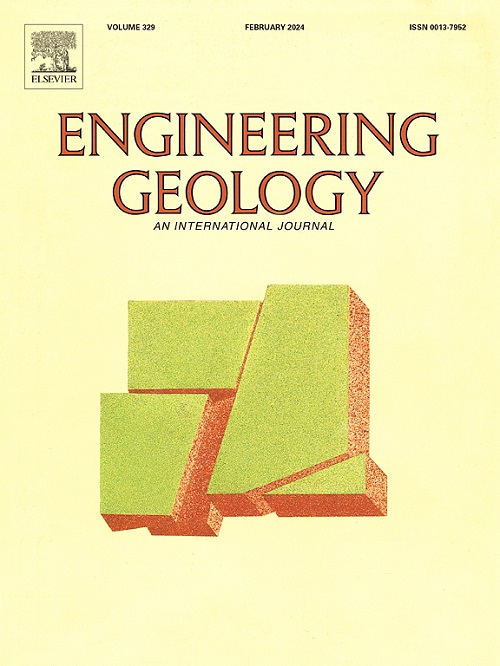三维岩石节理中二级岩石的剪切行为:基于形态的抗剪强度准则的实验研究与发展
IF 6.9
1区 工程技术
Q1 ENGINEERING, GEOLOGICAL
引用次数: 0
摘要
岩石失稳主要是由岩石节理的剪切破坏驱动的,节理的形态对岩石的剪切行为起着关键的控制作用。大多数现有的研究强调整体的关节形态,往往忽略了一阶和二阶突起的独特贡献。为了解决这一局限性,本文系统地研究了波纹度和不均匀度在影响岩石节理剪切行为中的作用。采用三维激光扫描和小波变换技术对节理形态进行分解。采用数字雕刻技术制作节理试件,进行平行直剪试验。结果表明,峰前应力积累阶段,波纹度主要决定峰值抗剪强度,而不均匀度则决定峰值抗剪强度。过高估计不均匀度的贡献会导致粗糙度对峰值抗剪强度影响的不准确评估。在高法向应力下,波浪状损伤的增加有助于抗剪强度的增加。基于这些发现,开发了一个剪切强度标准,整合了波浪和不均匀的不同形态贡献。根据实验数据验证后,所提出的准则显示出优越的预测准确性。这项工作提供了对剪切行为的多阶粗糙度贡献的更深入的理解。本文章由计算机程序翻译,如有差异,请以英文原文为准。
Shear behavior of two-order asperities in three-dimensional rock joints: Experimental investigation and development of a morphology-based shear strength criterion
Rock instability is predominantly driven by the shear failure of rock joints, with joint morphology playing a critical role in governing shear behavior. Most existing studies emphasize overall joint morphology, often neglecting the distinct contributions of first- and second-order asperities. To address this limitation, this paper systematically investigates the roles of waviness and unevenness in influencing the shear behavior of rock joints. Joint morphology was decomposed using three-dimensional laser scanning and wavelet transformation techniques. Digital carving technology was employed to fabricate rock joint specimens, which underwent parallel direct shear tests. The results indicate that waviness primarily governs peak shear strength, while unevenness contributes to shear behavior during the pre-peak stress accumulation stage. Overestimating the contribution of unevenness results in an inaccurate assessment of roughness effects on peak shear strength. At high normal stresses, increased damage to waviness contributed to shear strength increments. Based on these findings, a shear strength criterion was developed, integrating the differential morphological contributions of waviness and unevenness. The proposed criterion demonstrated superior predictive accuracy when validated against experimental data. This work provides a deeper understanding of the multi-order asperity contributions to shear behavior.
求助全文
通过发布文献求助,成功后即可免费获取论文全文。
去求助
来源期刊

Engineering Geology
地学-地球科学综合
CiteScore
13.70
自引率
12.20%
发文量
327
审稿时长
5.6 months
期刊介绍:
Engineering Geology, an international interdisciplinary journal, serves as a bridge between earth sciences and engineering, focusing on geological and geotechnical engineering. It welcomes studies with relevance to engineering, environmental concerns, and safety, catering to engineering geologists with backgrounds in geology or civil/mining engineering. Topics include applied geomorphology, structural geology, geophysics, geochemistry, environmental geology, hydrogeology, land use planning, natural hazards, remote sensing, soil and rock mechanics, and applied geotechnical engineering. The journal provides a platform for research at the intersection of geology and engineering disciplines.
 求助内容:
求助内容: 应助结果提醒方式:
应助结果提醒方式:


